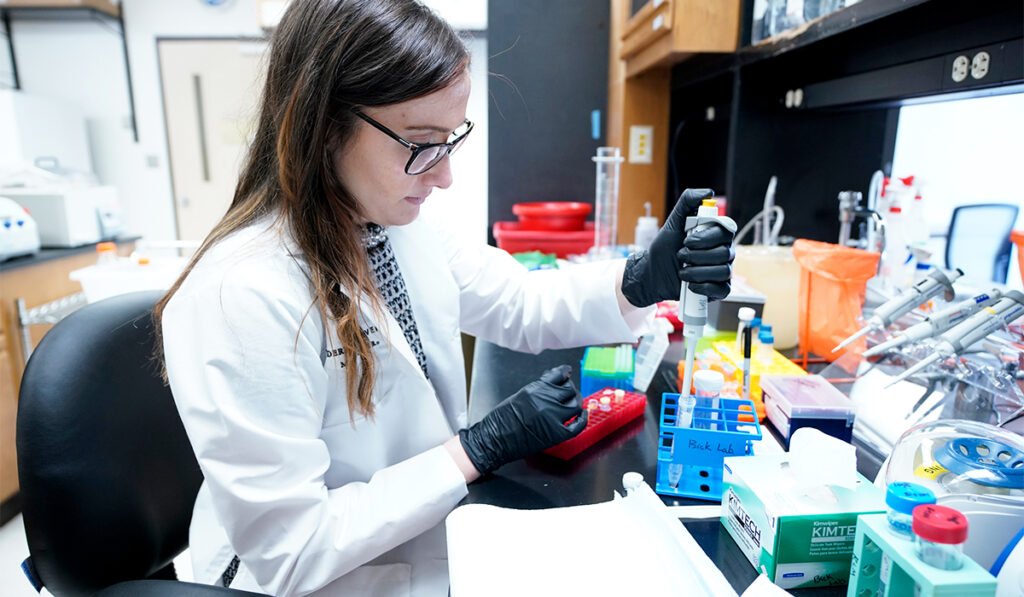The death of “X-Men” actor Adan Cantos at age 42 from appendiceal cancer in January 2024 propelled awareness of this rare cancer into the public eye. Although only affecting 1 to 2 people out of every million, confirmed cases rose 232 percent between 2000 and 2016.
“The challenge is, we don’t know why,” said Andreana Holowatyj, Ph.D., a molecular biologist and clinical epidemiologist at Vanderbilt University Medical Center. “Cancer of the appendix is typically discovered during surgery for acute appendicitis, and the rate of appendectomies has remained relatively stable.”
Holowatyj’s lab investigates the rising burden and emerging genomic patterns of appendiceal cancer. In 2023, she was part of an expert panel invited to evaluate the American Joint Committee on Cancer’s (AJCC) clinical staging guidelines for appendiceal cancer, which undergo routine evaluation every five to 10 years.
The nine criteria returned by the panel made no major changes in the way appendiceal cancers are staged. However, they did put forward the separation of three distinct histologies – non‐mucinous, mucinous, and signet‐ring cell – in describing prognostic variance.
Appendiceal cancer has unique and complex molecular features, yet much of the data so far on appendix cancer is extrapolated from colon cancer, the investigator said.
“When we think about the significant progress we’ve made in other cancers, there’s a big gap.”
In fact, she adds, the National Comprehensive Cancer Network offers no specific clinical guidelines for appendiceal cancer. They remain enveloped within the guidelines for colon cancer.
Survival Rates Compared
In the years since appendiceal cancer-staging guidelines were last revised, the AJCC has restructured its evaluation process to include prospectively collected data from the National Cancer Database, which captures roughly 72 percent of all patients with newly diagnosed cancer in the U.S. annually.
Survival analyses using these data as well as Version 8 of staging criteria issued by the Joint Committee on Cancer contributed to the Version 9 guidelines,. The primary objective was to evaluate prognosis by pathological stage groups and make revisions as indicated by the data.
“We’re doing a good job, but there is room for improvement in staging these cancers. We’ve come a long way, given the challenges in pathology across the field.”
“As we looked back at the Version 8 staging to see how the survival rates compared, the data demonstrated that some of the histologies, particularly the non-mucinous appendix cancers, do not have a hierarchical prognostic order,” Holowatyj said. “We still have further progress to make in refining stage group definitions with respect to the specific nuances of this disease.”
The Version 9 guidelines also demonstrate the clinical implications and challenges in staging heterogeneous and rare tumors.
“We’re doing a good job, but there is room for improvement in staging these cancers. We’ve come a long way, given the challenges in pathology across the field,” Holowatyj said. “What’s exciting is that we’ve helped the field recognize the need for more data specific to appendix cancer.”
Closing the Data Gap
To address this data challenge, Holowatyj launched the Genetics of Appendix Cancer (GAP) study at Vanderbilt-Ingram Cancer Center that aims to analyze hereditary factors, tumor characteristics and clinical features and outcomes among adults diagnosed with appendix cancer and their biological parents.
Holowatyj and colleagues had just published the first paper to look at germline genetic features in patients with appendiceal cancer. “The same day that paper published, we opened GAP,” she said.
The GAP study has been open for over one year and already has participants from 47 states. Qualifying patients are sent a saliva kit at no cost and their genetic data is incorporated in the study.
The response has been overwhelming, Holowatyj says.
“Of course, research is never as fast as clinical care, yet we share genetic information with patients to ensure they pursue additional follow-up for anything that has clinical implications.”
“We need creative thinking, collaborations and unique approaches to address rare cancers, which are understudied and underfunded.”
With time, she hopes the GAP study will provide data to help researchers develop a better biological and pathological picture of appendiceal cancer.
To that end, Holowatyj also chairs the scientific advisory board for the Appendix Cancer Pseudomyxoma Peritonei (ACPMP) Research Foundation. In December 2023, they launched the inaugural ACPMP Research Think Tank, hosted at Vanderbilt.
“We need creative thinking, collaborations and unique approaches to address rare cancers, which are understudied and underfunded,” she said.
Holowatyj hopes both efforts will be essential building blocks toward a better understanding of appendix cancer.
“The bigger the gap in knowledge, the bigger the impact we can make.”





